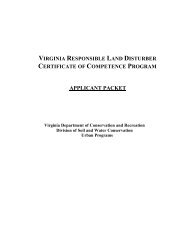Dameron Marsh NAP self-guided field trip guide - Virginia ...
Dameron Marsh NAP self-guided field trip guide - Virginia ...
Dameron Marsh NAP self-guided field trip guide - Virginia ...
Create successful ePaper yourself
Turn your PDF publications into a flip-book with our unique Google optimized e-Paper software.
Points of interest along the trail to the house and beach:<br />
1. The fresh-water pond:<br />
- Just past the sharp curve in the road there is a trail to a fresh-water pond: We will probably mow this trail again later this fall.<br />
2. The road north to the beach:<br />
- The road has been maintained for about half a century, and as a result of continual disturbance it contains many invasive species.<br />
- The large trees around the house are persimmons, not visible in the 1937 air photo.<br />
- The beach in front of the house and associated sand spit to the left constitute the fourth natural community found in the Preserve.<br />
The high energy beach is subject to constant wave erosion, exacerbated by high energy events like “northers” and hurricanes. On<br />
average, the erosion rate is about 4 feet per year, and 20(?) feet were lost during Hurricane Isabel in 2003. Approximately 250<br />
feet has been lost from the beach since 1937, and during that period sea level has risen approximately one foot.<br />
3. The beach and spit:<br />
- If the tide is low enough, you can climb down the small cliff to the beach. The cliff exposes a soil profile. At the land surface is<br />
the “A-horizon,” characterized by an accumulation of organic material. The sediment between the A-horizon and sea level is oxidized<br />
(rust-colored) and is being locally penetrated by roots. Hydrologically, the exposed cliff exposes the “unsaturated zone” in<br />
which the spaces between the grains of sediment are occupied by gas, not water.<br />
- If we could examine the sediment below sea level we would find that it is saturated with fresh water, but few roots would be present.<br />
Although some plants are adapted to saturated conditions (they have mechanisms to pump oxygen down into the submerged<br />
roots), most are not. This is the reason for the extensive ditching system we have seen, to increase the thickness of the unsaturated<br />
zone so crops could be grown.<br />
- You may see accumulations of black sand on the beach. The black grains are denser than the white grains, and geologists call<br />
them “heavy minerals.” Also called “accessory minerals” they are winnowed from the less dense minerals by the waves just as a<br />
miner pans for gold. The minerals can be traced back to specific rock units in the Appalachian Mountains, the ultimate source of<br />
all the sediment that constitutes <strong>Dameron</strong> <strong>Marsh</strong>.<br />
- If you are able to walk along the beach to the west (left) you will encounter muddy sediment containing abundant plant debris.<br />
This material, which might even be called peat, is the remnant of marshes that once existed here when the beach was north of its<br />
present position and sea level was lower. The marsh mud and intertwined rhizomes from marsh plants is difficult to erode and<br />
therefore it persists.<br />
- Sand eroded from the cliff has been moved offshore, and to the northwest where a sandy spit has developed. You can get to the<br />
spit by walking along the beach or by crossing a short stretch of marsh from the boat ramp. If you take that route, note the abandoned<br />
pier and pilings, indicating that this area was once open water. The sand spit enclosed this area and the low energy area<br />
behind the spit eventually developed into marsh, making the pier useless.<br />
- The sandy spit is extremely dynamic and is constantly changing. Small spits grow, enclose ponds, and then are breached by<br />
storms.<br />
- Animals found on the beach include.<br />
- Plants, some helping to stabilize the incipient dunes, include.<br />
4. The Loblolly Pine Forest:<br />
- The Loblolly Pine forests of <strong>Dameron</strong> <strong>Marsh</strong> contain understories of red maple, black cherry and sassafras. Shrubs include<br />
Southern Bayberry. There are also Muscadine Grapes and Greenbriers. This community is restricted to a narrow geographic<br />
range from Delaware to North Carolina, and this special habitat has been subject to intense development pressure. Maritime pine<br />
forests such as these at <strong>Dameron</strong> <strong>Marsh</strong> are considered globally uncommon to rare, and this is one of the communities that DCR<br />
is most anxious to preserve and expand.<br />
- Although the canopy and shrub layers of this community can be quite dense, the herbaceous (non-woody) layer is usually sparse.<br />
- The roots buffer erosion (seen in the air photos as differing shoreline position from adjacent salt marsh or <strong>field</strong>s) and filter both<br />
runoff and groundwater discharge into the Bay.<br />
****This final section of the trial <strong>guide</strong> was prepared by Lynton Land…..****<br />
****All other sections were a collaboration of all the <strong>guide</strong>s—most notably Susan Tipton and Carter Filer****<br />
For more information contact:<br />
<strong>Virginia</strong> Department of Conservation and Recreation<br />
Natural Heritage Program<br />
Chesapeake Bay Region Steward (804) 225-2302<br />
or<br />
217 Governor Street<br />
Richmond, VA 23219 (804) 786-7951<br />
website: www.dcr.virginia.gov/dnh<br />
May 2005
















